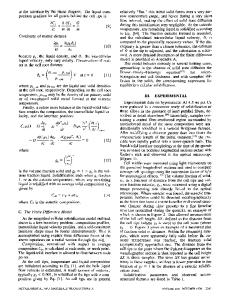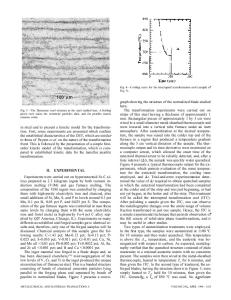Study of the Eutectoid Transformation in Nodular Cast Irons in Relation to Solidification Microsegregation
- PDF / 2,526,359 Bytes
- 10 Pages / 593.972 x 792 pts Page_size
- 76 Downloads / 287 Views
ODUCTION
THE final matrix of common nodular cast irons results from the eutectoid decomposition of high-temperature austenite and consists in either ferrite, pearlite, or a mixture of ferrite and pearlite. The former eutectoid transformation proceeds in the stable system (austenite fi ferrite + graphite), the latter in the metastable system (austenite fi ferrite + cementite). In practice, a low cooling rate is used during the eutectoid reaction in order to ensure a fully ferritic matrix. On the opposite, pearlite promoter elements such as Cu, Mn, Sb, or Sn are added to cast iron alloys for getting a fully pearlitic matrix even at quite low cooling rate. Mastering of cooling conditions and alloy composition for obtaining a desired microstructure is made complicated because of chemical heterogeneities build-up during solidification, the so-called microsegregations. Heterogeneities in carbon are easily handled because this element diffuses quite fast in austenite. On the contrary homogenization of all elements but C and N cannot be carried out by any practical means, so that the eutectoid transformation takes place locally under ALEXANDRE FREULON, Technician, and JACQUES LACAZE, Senior Scientist, are with CIRIMAT, Universite´ de Toulouse, ENSIACET, CS 44362, 31030 Toulouse, France. Contact e-mail: [email protected] PHILIPPE DE PARSEVAL, Research Engineer, is with GET, UMR 5563 CNRS, Universite´ de Toulouse, 14 Avenue Edouard Belin, 31400 Toulouse, France, and also with the Centre de Microcaracte´risation Raimond Castaing, Universite´ de Toulouse, UMS 3623, 3 rue Caroline Aigle, 31400 Toulouse, France. CLAUDIE JOSSE, Engineer, is with the Centre de Microcaracte´risation Raimond Castaing, Universite´ de Toulouse, France. JACQUES BOURDIE, Ph.D. Student, is with CIRIMAT, Universite´ de Toulouse, and also with Saint-Gobain Pont-a`-Mousson, 21 avenue C. Cavallier, 54700 Pont-a`-Mousson, France. Manuscript submitted March 10, 2016. Article published online August 12, 2016 5362—VOLUME 47A, NOVEMBER 2016
conditions that change at the microstructure scale.[1–3] The first aim of this work was to characterize the distribution of the elements at the local scale and to investigate if the eutectoid transformation may have affected the distribution issued from solidification. Very little of tin or antimony, meaning less than 0.1 mass pct, is effective in decreasing the amount of ferrite, when 0.5 to 1.0 mass pct of copper and/or manganese is necessary to significantly decrease it. This suggests that the pearlite promoter effect of these various elements proceeds by different mechanisms. While a mechanism has been proposed for explaining the role of copper and manganese,[4] it has been observed that tin proceeds in a different way[5] and it is suspected that antimony affects the eutectoid transformation as tin does. The present work was also carried out to look for similarities with tin in case of low antimony addition. In the present study a common nodular cast iron without and with a small addition of antimony was prepared and cast in bl
Data Loading...









